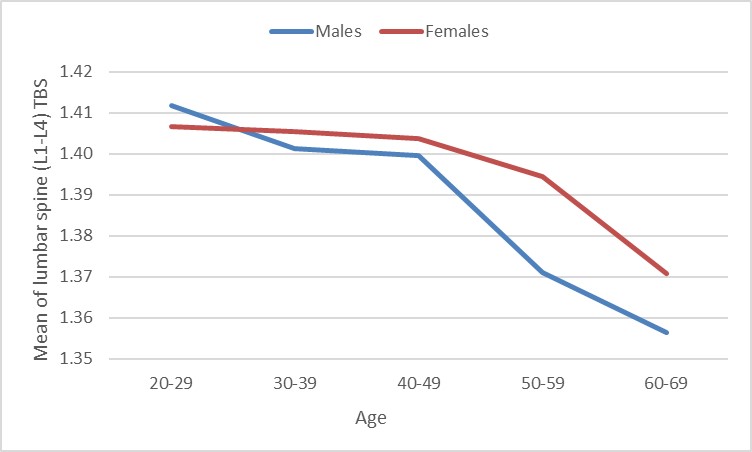Session Information
Date: Monday, November 18, 2024
Title: Osteoporosis & Metabolic Bone Disease – Basic & Clinical Science Poster
Session Type: Poster Session C
Session Time: 10:30AM-12:30PM
Background/Purpose: Trabecular bone score (TBS iNsight™) is an advanced imaging software application for bone densitometers (DXA). TBS gives an assessment of bone architecture by estimating the standard deviation of a patient’s TBS to the average TBS of a healthy Caucasian young white females (T-score) or to the age-sex matched population (Z-score). Currently, TBS is integrated in fracture risk assessment (FRAX®) tool. Based on the available hip fracture data from the gulf cooperation council (GCC) countries, the incidence rate of fragility fracture is much lower to that of European and North American populations which makes populations from GCC to have a lower probability of fracture risk when these fracture data are used to formulate each nation fracture risk assessment (FRAX®) tool. In light of this, we hypothesized that the bone mineral density (BMD) and TBS of Arab population is also different from North America and European countries. The aim of this study is to generate a reference TBS curve of lumbar spine (L1-L4) from Qatari healthy individuals.
Methods: BMD readings of Qatari individuals aged between 20 to 69 years old were obtained from Qatar Biobank i-DXA (Lunar®) database. The exclusion criteria were: history of major osteoporotic fracture, renal impairment (eGFR< 60 ml/min), primary hypo/hyper parathyroid diseases, uncontrolled hyperthyroidism, hyperadrenalism, hypogonadism, active malignancy or history of malignancy, chronic liver diseases, inflammatory bowel disease, uncontrolled diabetes mellitus type II (Hb A1C > 6.5), diabetes mellitus type I, early oophorectomy or early menopause (below age of 45), severe deficiency of 25 hydroxy vitamin D < 20 ng/ml (50nmol/L), any autoimmune rheumatic diseases, history of using anti-osteoporosis drugs, chronic use of systemic glucocorticoid, sex hormone deprivation therapy, anticonvulsants and heparin, body mass index less than 18 or more than 35 kg/m2 and participants with short stature < 150 cm. The study population was divided into five 10-year age groups: 20-29, 30-39, 40-49, 50-59, and 60-69. Conventionally, the sample size of 30 is sufficient for normative measures.
Results: 518 subjects were captured. Female to male ratio for each age group 20-29, 30-39, 40-49, 50-59, and 60-69 was 60:51, 76:78, 39:47, 40:40 and 41:46, respectively. Mean body mass index (±SD) of males was 27.0 (±3.71) and of females was 27.5 (±4.01). Mean (±SD) TBS of males was 1.39 (±0.072) and of females was 1.37 (±0.098). The means TBS of both genders were quite similar at different age groups and drop with aging.
Conclusion: The mean TBS of the healthy Qatari individuals is 1.39 for males and 1.37 for females which is quite matching the European population.
To cite this abstract in AMA style:
Alsaed O, Didier H, Alemadi S. Trabecular Bone Score Curve from a Qatari Population, Data from Qatar Biobank [abstract]. Arthritis Rheumatol. 2024; 76 (suppl 9). https://acrabstracts.org/abstract/trabecular-bone-score-curve-from-a-qatari-population-data-from-qatar-biobank/. Accessed .« Back to ACR Convergence 2024
ACR Meeting Abstracts - https://acrabstracts.org/abstract/trabecular-bone-score-curve-from-a-qatari-population-data-from-qatar-biobank/

